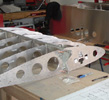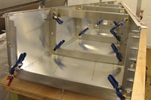


random user submitted photo
Aerovee intake ports thick black residue
8 posts
• Page 1 of 1
Aerovee intake ports thick black residue
Hi Peeps,
I am doing a deep inspection on an Aerovee and have noticed a thick black waxy residue in the inlet ports and extend back up the intake manifold. Obviously this will do little in maintaining existing volumetric efficiency and a gradual power loss over time.
I suspect it’s reversion due to probably poor exhaust flow as there is virtually no exhaust scavenging on the Onex exhaust system layout, but then until I look at it in more detail, I’m guessing.
So my question simply is, have other Aerovee operators noticed very black deposits in the inlet ports and back down the inlet manifold?
Regards,
HH
I am doing a deep inspection on an Aerovee and have noticed a thick black waxy residue in the inlet ports and extend back up the intake manifold. Obviously this will do little in maintaining existing volumetric efficiency and a gradual power loss over time.
I suspect it’s reversion due to probably poor exhaust flow as there is virtually no exhaust scavenging on the Onex exhaust system layout, but then until I look at it in more detail, I’m guessing.
So my question simply is, have other Aerovee operators noticed very black deposits in the inlet ports and back down the inlet manifold?
Regards,
HH
- Hap Hazard
- Posts: 18
- Joined: Mon Dec 13, 2021 1:47 am
Re: Aerovee intake ports thick black residue
Yep, I've seen it. Others have posed the question.
Bryan Cotton
Poplar Grove, IL C77
Waiex 191 N191YX
Taildragger, Aerovee, acro ailerons
dual sticks with sport trainer controls
Prebuilt spars and machined angle kit
Year 2 flying and approaching 200 hours December 23
Poplar Grove, IL C77
Waiex 191 N191YX
Taildragger, Aerovee, acro ailerons
dual sticks with sport trainer controls
Prebuilt spars and machined angle kit
Year 2 flying and approaching 200 hours December 23
-

Bryan Cotton - Posts: 5035
- Joined: Mon Jul 01, 2013 9:54 pm
- Location: C77
Re: Aerovee intake ports thick black residue
Bryan Cotton wrote:Yep, I've seen it. Others have posed the question.
Is there a solution?
Bob Dz...
Sonex B, Tri-gear
(technically within walking distance of Sonex)
N624DZ (reserved)
Plans exist to eliminate confusion, not create it.
Sonex B, Tri-gear
(technically within walking distance of Sonex)
N624DZ (reserved)
Plans exist to eliminate confusion, not create it.
- BobDz
- Posts: 259
- Joined: Mon Oct 02, 2023 3:44 pm
Re: Aerovee intake ports thick black residue
I wipe out the manifolds during annual if they seem like they need it. I guess my residue is not thick. I run 100LL and use decalin to scavenge the lead. It's not really fouled up on me. I'd vote that it's not an issue. I would be curious if it was cleaner on auto gas.
Bryan Cotton
Poplar Grove, IL C77
Waiex 191 N191YX
Taildragger, Aerovee, acro ailerons
dual sticks with sport trainer controls
Prebuilt spars and machined angle kit
Year 2 flying and approaching 200 hours December 23
Poplar Grove, IL C77
Waiex 191 N191YX
Taildragger, Aerovee, acro ailerons
dual sticks with sport trainer controls
Prebuilt spars and machined angle kit
Year 2 flying and approaching 200 hours December 23
-

Bryan Cotton - Posts: 5035
- Joined: Mon Jul 01, 2013 9:54 pm
- Location: C77
Re: Aerovee intake ports thick black residue
BobDz wrote:Bryan Cotton wrote:Yep, I've seen it. Others have posed the question.
Is there a solution?
There can be more than one reason, things like valve duration, overlap, mixture/fuel etc, but I suspect it’s probably down to the exhaust design? As I don’t have ready or cheap access to a Dyno and have no desire to fine-tune it to the “nth” degree, I will largely remain guessing…not much help I know.
The answer to the exhaust design should be fairly easy to answer as I recall flying a VP1 years ago (for a couple of years) and from memory the inlets were virtually free of any blackening and were almost as clean as the day fitted. It used exhaust stubs, which chucks the exhaust overboard PDQ, therefore no back pressure, but they are as noisy as a Trump Rally….
The next best thing (far better in fact) is a tuned length exhaust. I remember making up a tuned length exhaust for a Formula Vee racing car when I was a teenager, from memory, it was around 45 inches from exhaust port to collector (there was at the time a generic figure floating around the Vee scene and not taken from any of my dubious calculations!). It then ran into a mandatory expansion chamber (crude silencer). The reason as to why I refer to this is not to boast, but to make the point, exhaust systems really do matter to engine performance, but a Formula Vee is like comparing apples to pears, as the Formula Vee world was most concerned with a power-band in accelerating around 1200 lbs of car from around 4000- up to 6000 rpm. We in the the VW aviation world, are turning at half these revs, so tuned pipes are much longer for lower RPM, with pipe lengths probably in the region of mid 50’s (inches) and more (again I am guessing).
For us, exhaust systems are governed by tight, fiddly engine cowls and a hell of a lot of heat under there running uncomfortably close to fuel systems etc, promoting fuel vaporisation, and worse, every aviators biggest fear, fire.
The best article by far on the subject that I’ve come across for aircraft is here: https://www.kitplanes.com/engine-theory-4/
(Note that poor exhaust design also leads to higher head temperatures, the Achilles heal of the Type 1 VW engine, so careful design isn’t to be sniffed at).
So steering myself back to my original question, thick gungy, waxy soot in the intake manifold…. There is a potentially, and relatively easy way to answer this. Revmaster, who IMHO, engineered the best VW conversion to date, used to (maybe still do?) market a 4-into 1 exhaust system for their big-bore VW engines. It would be relatively easy to pose the question to both those who fly stubs or the KR2 style, Revmaster exhaust, if they are experiencing the same issues to the same degree?
To many owners that subscribe to the Sonex tried and trusted ethos of KISS, then you either remain oblivious or live with built in issues that might not be designed for optimum performance for the given application (and for the more fastidious, appreciative owners, squirting brake cleaner every now and then down your inlet ports). But to be fair to Sonex, they have by in large, engineered a lovely product and the proof is in the operation and many satisfied customers, hopefully myself included with my new purchase (they have been great to date I might add and in an environment that has armchair experts in the VW world, like myself, popping up regularly! LOL).
So what can be done you ask? Well looking at my factory exhaust, it certainly can be improved with a few relatively small mods. There are two avenues I am looking at which MAY improve both the black soot issue, and give a little more power.
Firstly, a simple mod will be to install an “H” pipe just aft of the exhaust joint. This is a simple way of balancing exhaust pressures on each bank of cylinders/pipes. The current independent layout cannot be efficient, so an H-pipe, in theory, should be better for low down torque (read us) than an “X” pipe. Either way, it has to be an improvement for little weight. The other way is to swing the exhaust pipe from cylinders 1 and 3 and pipe them to the opposite bank, in other words, a cross over system, but until I get the engine back in the aircraft, I am not sure if the inlet manifold etc gets in the way of this option and what will be the better way to go?.
As the airfield I fly from is very noise sensitive, then I am also considering a small carbon fibre “motorcycle” style silencer hung below the firewall, but then tip noise is probably worse…but that’s not in the scope of this conversation really….
So in a nutshell, if people running a VW with stubs, or a 4-into one system, notice cleaner intakes, then I would suggest that poor exhaust flow is probably the culprit, after all, looking at generic figures for the main VW aircraft engine providers (including Sonex), they look to be running pretty much the same specs, including rod ratios, and probably cams etc (read valve durations, which can play a big part). Engine design is like 3-d chess, Im still stuck on domino’s….but at the end of the day, I will have answered my own question in a few months time after I get my Onex back in the air after I carry out my exhaust mod???
HH
- Hap Hazard
- Posts: 18
- Joined: Mon Dec 13, 2021 1:47 am
Re: Aerovee intake ports thick black residue
Saw same on my Jabiru 3300 which was made in to 2008 and it was due to its hydraulic lifters over pumping. So would look towards valves even though the reason why the intake valves are staying open too long and allowing exhaust to be pushed back into the intake is not likely to be same. (I replaced the hydraulic lifter Jabiru with a solid lifter CAMit, end of problem.)
David A.
David A.
- DCASonex
- Posts: 904
- Joined: Mon Sep 12, 2011 8:04 pm
- Location: Western NY USA
Re: Aerovee intake ports thick black residue
You may be overthinking the problem. The intake manifold is bent on a tube bender machine which I'm very familiar with. They use a waxy lubricant inside the tubing while a shaped, flexible, rod is inserted before bending to prevent kinking in the bend. I neglected to clean the inside of my manifold and the gunk drained down into the Aeroinjector slide valve and caused it to stick, resulting in a wide open start after an adjustment.
OneX 107
N2107X
N2107X
- Onex107
- Posts: 494
- Joined: Mon Mar 24, 2014 6:44 pm
- Location: Peoria, IL
Re: Aerovee intake ports thick black residue
The lack of valve guide seals allows oil to be sucked past the stem/guide and get deposited in the intake tract.
My solution was to never let the engine run below 8000rpm to keep the vacuum low in the intake.
My solution was to never let the engine run below 8000rpm to keep the vacuum low in the intake.
- Area 51%
- Posts: 733
- Joined: Thu Feb 18, 2016 7:57 am
8 posts
• Page 1 of 1
Who is online
Users browsing this forum: Bing [Bot] and 8 guests







